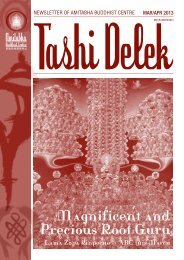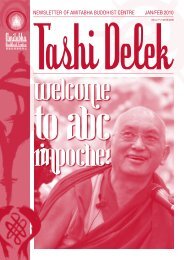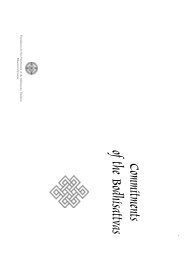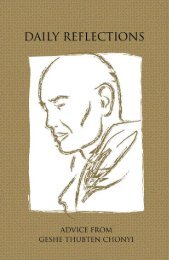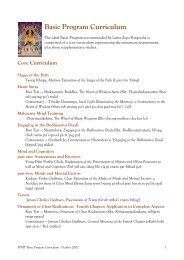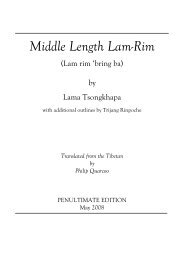How to Generate Bodhicitta (English) - Amitabha Buddhist Centre
How to Generate Bodhicitta (English) - Amitabha Buddhist Centre
How to Generate Bodhicitta (English) - Amitabha Buddhist Centre
Create successful ePaper yourself
Turn your PDF publications into a flip-book with our unique Google optimized e-Paper software.
THE SEVEN-POINT CAUSE-AND-EFFECT INSTRUCTION<strong>Bodhicitta</strong>, the aspiration <strong>to</strong> attain enlightenment in order <strong>to</strong> benefit all sentient beings, is something that istruly inconceivable, truly splendid and marvellous. One of the great gurus of Lama Atisha <strong>to</strong>ld him that anattainment such as clairvoyance, or a vision of a deity, or concentration as stable as a mountain is nothingcompared <strong>to</strong> bodhicitta. For us, these attainments seem amazing. If we ourselves, or if someone we heard of,had a visioon of a deity, achieved clairvoyance, or through practising meditation attained concentration asstable as a mountain, we would think this <strong>to</strong> be unbelievably wonderful. <strong>How</strong>ever. Atisha's guru said <strong>to</strong> him:"These are nothing compared <strong>to</strong> bodhicitta. Therefore, practise bodhicitta."Even if you practised mahamudra or dzogchen or the two stages of highest yoga tantra [generation stage andcompletion stage] and even if you achieved the vision of many deities, these are not beneficial if you do nothave bodhicitta.As the great Bodhisattva Shantideva said, "If you churn the 84,000 teachings of the Buddha, their essence isbodhicitta." By churning milk we get butter, which is the very essence of milk. In the same way, if we examineand churn all the 84,000 teachings of the Buddha, their very essence is the practice of bodhicitta. Therefore, itis extremely important for us <strong>to</strong> strive <strong>to</strong> achieve the uncontrived, effortless experience of bodhicitta. At thevery least, we should try our best <strong>to</strong> generate the contrived experience of bodhicitta, the bodhicitta that arisesthrough effort.There are two main lineages of instructions on the basis of which you can practise and generate bodhicitta.The first is the seven-point cause-and-effect instruction on exchanging oneself and others.The first, the seven-point cause-and-effect instruction by which you generate bodhicitta on the basis ofdeveloping affectionate love <strong>to</strong>wards all sentient beings, is a practice which was used by such great Indianpandits as Chadrakirti, Chandragomin, Shantarakshita and so forth. The second, the instruction onexchanging oneself with others, comes mainly from Shantideva. Whether you choose <strong>to</strong> train your miind in theseven-point cause-and-effect instruction or in exchanging oneself with others, the result is that you willgenerate bodhicitta in your mind.The great saint Atisha showed extraordinary interest in bodhicitta. In order <strong>to</strong> obtain the complete instructionson the practice of bodhiciita, he embarked on a long journey <strong>to</strong> the Indonesian island of Sumatra <strong>to</strong> study withthe great master Serlingpa, not caring about the many hardships he endured on the way. Today we can travel<strong>to</strong> Indonesia by a very fast ship or by airplane, but at that time it <strong>to</strong>ok Atisha thirteen months <strong>to</strong> reachIndonesia. Once he arrived, he received the complete expereintial instruction on both the seven-pointtechnique and exchanging oneself with others from the master Serlingpa. He then practised for twelve yearsat his master's feet, until he fully developed bodhicitta. Thus Lama Atisha came <strong>to</strong> possess both instructionlineages: the seven-point technique and exchanging oneself with others.Although he held both lineages, Atisha would teach only the seven-point technique in public, <strong>to</strong> largeassemblies of disciples, and would teach instructions on exchanging oneself with others secretly <strong>to</strong> a selectgroup of qualified disciples. When Atisha went <strong>to</strong> Tibet, he gave the instructions on exchanging oneself withothers only <strong>to</strong> his principal disciple, Drom<strong>to</strong>npa.Later, the great Lama Tsong Khapa, the Protecor of all beings, incorporated the two sets of instructions in<strong>to</strong> asingle practice consisting of eleven points. When you are receiving teachings on bodhicitta, you receive thetwo sets of instructions separately, but when you are actually meditating on bodhicitta—training your mind—then you combine both instructions and meditate on the eleven points. Combining the two instructions in<strong>to</strong> asingle practice for the purpose of training the mind in meditation is said <strong>to</strong> be a particular greatness of theGelugpa tradition.In a prayer composed by Lama Pabongka Dorje Chang requesting <strong>to</strong> meet the doctrine of Lama Tsong Khapa,he wrote: "By merging the practices of the seven-point mind technique and exchanging oneself with others ofthe precious mind, this greatness which is not shared by others, may I thus be able <strong>to</strong> meet the doctrine ofLama Tsong Khapa." "Not shared by others" means that this merging of the two practices devised by JeRinpoche is a unique approach which is not found in other traditions.






